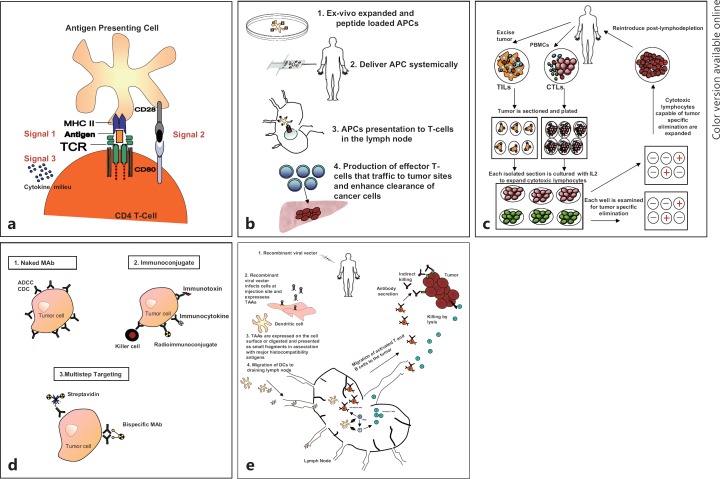Fig. 2.
Antigen presentation and immune therapy. (a) General concept of antigen presentation: Professional APC presenting an acquired antigen to a naïve CD4 T cell via the interaction between its peptide–MHC complex and the T-cell receptor (TCR, Signal 1). In the presence of a concomitant interaction between CD28 and CD80 (Signal 2), this will lead to T-cell activation. Signal 3: The characteristic composition of the cytokine milieu determines the type of effector CD4 T cell (regulatory T cell, or helper T cell, etc.) that will emerge. (b) Antigen presentation as a therapeutic strategy: (1) Selected antigens (Glypican-3, MAGE-A3, MAGE-A1) are loaded onto ex vivo APCs (e.g., dendritic cells). (2) The APCs are then delivered systemically. (3) APCs migrate to the lymph nodes, where their cargo antigens are presented tonaïve T cells, and activate them. (4) The activated T cells expand and migrate to the tumor, inducing tumor clearance. (c) Adoptive cell transfer: TILs or CTLs are isolated from patient specimens. The isolated cells are expanded by culturing with IL-2. The cells are then assayed for tumor-specific elimination. Cells with the unique ability to specifically eliminate tumors are expanded and reintroduced after lymphodepletion. These cells are capable of migrating to the tumor and have the potential to eliminate the tumor. (d) Antibody therapy: (1) Naked monoclonal antibodies (MAb) have been designed to specifically bind to receptors or surface molecules that are uniquely expressed by tumor cells and induce cell death via antibody-dependent cellular cytotoxicity (ADCC) or complement-dependent cytotoxicity. (2) Immunoconjugate: Antibodies have also been designed to carry payloads that are engineered to induce cell death. (3) Multistep targeting: Antibodies serve as an intermediary between the tumor cells and the targeting payloads. (e) Viral vectors: (1) recombinant viral vectors can be engineered to induce an immunologic response, and also to express selected tumor-associated antigens (TAAs). (2) Upon systemic infusion the viral vectors can selectively infect and induce tumor cell death. (3) The death of these tumor cells results in the release of tumor-specific peptide fragments that are taken up by APCs (i.e., dendritic cells) and expressed on the cell surface via their MHC. (4) Antigen-expressing APCs migrate to lymph nodes where they are exposed to and educate T and B lymphocytes. Educated T cells from the lymph nodes expand and home to the tumor where tumor cell lysis is induced.

